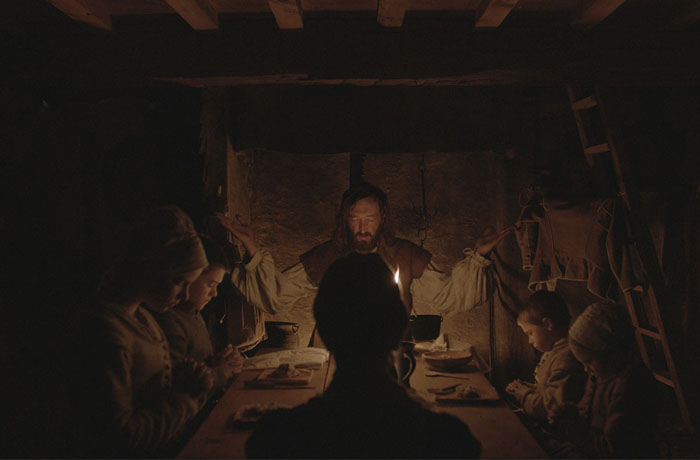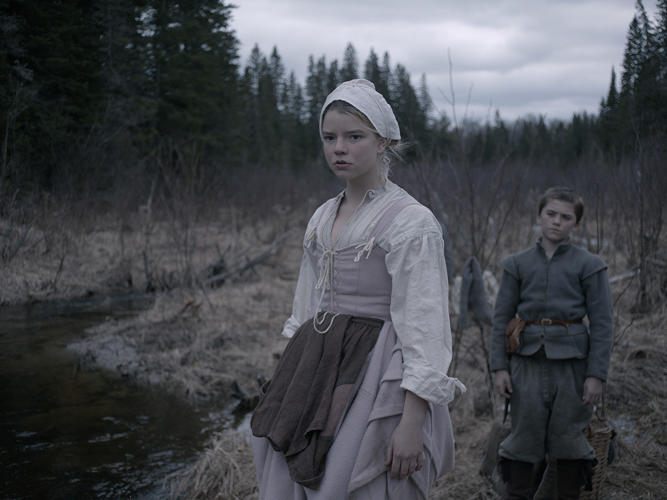The early years of America have been the source of countless folk tales and superstitious stories. The most effective and haunting are, of course, the works of H.P. Lovecraft, who drew upon stories from the lost era of Wyrd America. So, in this Lovecraftian vein, comes the wonderfully assured debut film from Robert Eggers, The Witch (stylised as The Vvitch, to evoke Jacobean era pamphlets on witchcraft). The Vvitch is a masterpiece of both slow-burning horror and of impeccable technique. In an era of big-budgeted jump-scare blockbusters, a quiet revolution is occurring in the genre emphasising new and old elements, with films such as The Babadook, You’re Next, It Follows and Green Room. And The Vvitch is arguably the best of the lot.
It’s the 1630s and New England man William (Ralph Ineson) finds himself at odds with his Puritan plantation over interpretations of the New Testament. Facing banishment William, his wife Katherine (Kate Dickie), eldest daughter Thomasin (Anya Taylor-Joy), son Caleb (Harvey Scrimshaw), twins Mercy and Jonas and newborn Samuel settle into a farm, built far away from the village on the edge of a secluded and large forest. The family attempt to make a life for themselves in this unforgiving land, along with a menagerie of animals, including the children’s favourite goat, Black Philip. Thomasin and the children begin to stare into the void of the forest. And, like the characters discover in a H.P. Lovecraft story, the void stares back. Horror and madness begin to fester in the family when, one day, baby Samuel vanishes. Accusations of witches and devil work are tossed around, with suspicion and religious paranoia sinking in deeper and deeper, with much of the blame falling to Thomasin (on the verge of womanhood). Revealing too much more would undermine the effectiveness of the film. Needless to say the plot unfurls from here slowly and steadily, relishing in each horrific reveal.
Eggers forgoes the usual jump scares or copious amounts of blood seen in horror blockbusters. Like the steady stirring of a cauldron, Eggers is in no rush to spoil the rich brew he has concocted. The first major accomplishment is how we feel we have been transported back to the 1630s. The dialogue is written perfectly to evoke this era. Eggers did extreme research into old journals and accounts from the era to correctly represent the way its residents would speak. To further evoke this attention to detail, the production team even went so far as to build the set using 17th century techniques. The dialogue and wonderful set and costume design are complemented with the decision to film using natural-light. Like Kubrick with Barry Lyndon, Eggers understands the best way to evoke an older time is to employ natural lighting and not to rely on studio lighting. We have wonderful shots of candlelit dinners, fighting off the impending blackness, moonlit walks in the forest and heated discussions set against the twilight hour. Finally, the decision was made to shoot in 1:66:1 aspect ratio, which gives the frame extra height to allow those massive trees to loom over the characters.
All this gives a sense of reality and gloominess to the film. Eggers creates a world in which reality and the supernatural can intermingle. He states that “the key to creating this whole thing was understanding that the real world and the fairy tale world were the same thing in the early modern period, except for in the minds of the extreme intelligentsia. Everyday life was imbued with the supernatural. Witches were as real as mud, shit, the breeze and God. (1)” Thus, the film's technique works to imbue this mindset into every frame, backed by the discordant soundtrack by Mark Korven and the brilliantly creepy sound design. There are some truly unforgettable images in this film that evoke horror and fairy tales. Again, I don't want to reveal too much but needless to say you’ll be contemplating their effectiveness for days to come.
At the centre of this madness is Thomasin. A young girl on the edge of womanhood, who finds herself at the centre of the family’s suspicions and anger. Anya Taylor-Joy commands the attention of every scene she is in. She manages to perfectly balance a wide-eyed innocence with a slight edge that could be mis-interpreted as sinister. However, Harvey Scrimshaw as Caleb is equally great and has to act with the toughest material. Caleb is also on the verge of puberty, casting ashamed looks at his sister’s chest, and has to live up to his father’s shadow. Some of the most horrifying elements of the film centre around Caleb so I will stop here. Kate Dickie seems to be building a career around playing insane and hysterical mothers, having played Lysa Arryn in Game of Thrones, and here this is magnified with a religious zealotry. Deeply unhappy with the situation she lives in, Katherine is a pressure cooker waiting to explode. Against this is Ralph Ineson, the family patriarch, who is filled with quiet pride and determination to make their lives work with an almost mad zeal. A simple task of chopping wood becomes a worryingly compulsive activity for William. The best thing about Dickie and Ineson is how absorbed they are into their roles. They are the most recognisable faces of the cast but their performances are so compelling you just become absorbed into their characters. The cast works in a similar way to Kubrick’s The Shining. We are stuck with these characters as their mounting cabin fever and madness threatens to tear them apart.
The Vvitch is a modern masterpiece of horror. Employing a Kubrick-style approach to his filmmaking, Eggers has produced an unforgettable debut feature that taps directly into fears of religious persecution, sexual awakening, social isolation and man vs. nature. The film perfectly transports you back to a time when witches and folk stories felt very real to its residents, with only religion as solace. Its slow pace may not be for everyone but the result is a mood of constant dread as it reaches its haunting finale. Eggers draws upon primordial fears and puts a modern spin on it by evoking oppression and misogny. One of the best modern horror films that I can't recommend enough. I have kept details slight in the review, as it is best just experienced with as little knowledge as possible. William asks the Puritan court at the start of the film “What went we out into this wilderness to find?” and states to find the kingdom of God. The reality of what the family finds at the end is far from it.
Rating: 10/10
Rating: 10/10
References
(1) http://www.indiewire.com/2016/02/how-robert-eggers-used-real-historical-accounts-to-create-his-horror-sensation-the-witch-67882/



No comments:
Post a Comment